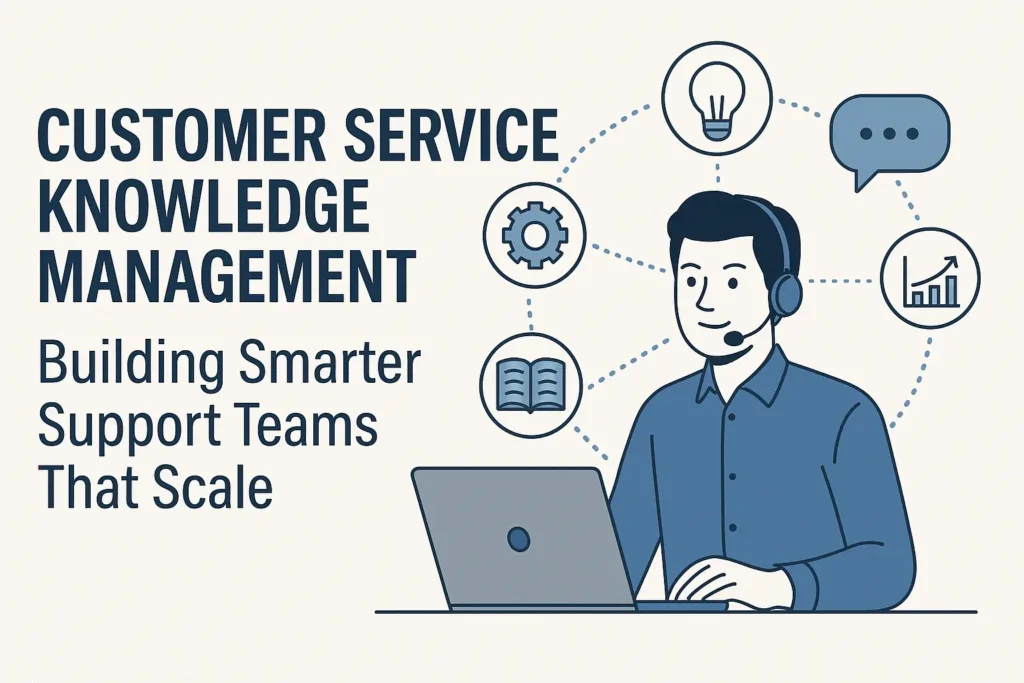Customer service is no longer just about resolving tickets or answering calls. It has become a defining factor in how customers perceive and stay loyal to a brand. Yet, behind every quick, accurate, and empathetic response lies something less visible but immensely powerful — knowledge. This is where customer service knowledge management plays its most transformative role.
Knowledge management (KM) is not just an internal tool for documentation; it is the foundation of intelligent, consistent, and scalable customer experiences. Companies that master it can empower support teams, reduce costs, and turn customer insights into continuous improvement.
Let’s explore how knowledge management can redefine the way customer service operates, creating a smarter and more sustainable system for global organizations.

Understanding Customer Service Knowledge Management
At its core, customer service knowledge management is the process of capturing, organizing, sharing, and continuously improving the information that customer-facing teams rely on. This includes FAQs, troubleshooting guides, workflows, escalation protocols, product documentation, and best practices gathered from past interactions.
In simple terms, it ensures that the right information reaches the right person at the right time — whether that person is a support agent or the customer themselves.
When structured effectively, a KM system becomes a living repository that evolves with every ticket closed, every update deployed, and every insight gained. This is not about static manuals or disconnected wikis; it’s about building a dynamic knowledge ecosystem that supports decision-making and service delivery.
Why Knowledge Management Matters in Customer Service
Modern customer expectations have shifted dramatically. Today’s customers expect answers instantly, on their preferred channels, and with zero friction. For service teams, that means speed, accuracy, and consistency are no longer optional — they are the baseline.
Without an organized KM framework, customer service operations often struggle with:
- Repetitive problem-solving due to lack of centralized knowledge
- Inconsistent information across teams and regions
- Longer resolution times and customer frustration
- Difficulty training new agents quickly
A well-implemented customer service knowledge management system eliminates these inefficiencies. It helps service teams deliver faster, more reliable responses while maintaining quality and tone across all interactions.
In other words, it transforms reactive service into proactive intelligence.
The Core Components of a Customer Service KM System
A modern knowledge management system for customer service is built around several interconnected components that work together to ensure knowledge is both usable and actionable.
1. Centralized Knowledge Base
A unified, searchable knowledge base acts as the single source of truth for both customers and support agents. It should be easily accessible, categorized intelligently, and continuously updated based on feedback and analytics.
2. Content Governance and Quality Control
High-quality, accurate content is the backbone of effective KM. Governance frameworks define how knowledge is created, reviewed, and approved, ensuring consistency and accuracy across languages, products, and markets.
3. Integration with Support Platforms
Your KM system should not exist in isolation. Integration with CRM tools, chatbots, and ticketing systems ensures that information flows naturally into daily workflows. This eliminates friction and enables agents to access relevant knowledge without switching contexts.
4. Continuous Feedback Loops
Every customer interaction generates valuable data. Feedback from these interactions should feed directly into the knowledge base, improving the accuracy and relevance of content over time.
5. AI-Powered Search and Insights
Artificial intelligence enhances discoverability and relevance. AI tools can recommend articles, detect outdated content, and analyze user behavior to optimize search performance — helping agents and customers find answers faster.
Benefits of Customer Service Knowledge Management
When done right, knowledge management reshapes not only service efficiency but also organizational learning and customer trust.
Here are the key benefits that leading organizations experience:
1. Faster Resolution and Reduced Handling Time
Agents no longer spend time searching across multiple systems. Centralized, searchable knowledge allows them to resolve issues within seconds, improving first-contact resolution rates.
2. Consistency Across Teams and Channels
Whether a customer contacts support through email, live chat, or phone, they receive the same accurate information. This builds reliability and brand confidence.
3. Reduced Training and Onboarding Time
New hires can ramp up faster when guided by structured knowledge bases and process documentation. Instead of shadowing senior agents for weeks, they can access curated learning pathways within the KM system.
4. Lower Operational Costs
As agents work more efficiently and self-service tools improve, call volumes decrease, and support costs drop. Companies can scale operations without proportionally increasing headcount.
5. Enhanced Self-Service Experience
A strong KM foundation allows customers to find answers independently through well-organized help centers, AI chatbots, or FAQs — all powered by the same centralized knowledge base.
6. Continuous Learning and Improvement
Every customer query reveals patterns and gaps in existing knowledge. With proper analytics, service teams can identify emerging issues early, improving product quality and customer satisfaction.
Real-World Examples of Knowledge Management in Action
Global enterprises are already proving how customer service knowledge management drives measurable impact.
1. Microsoft
Microsoft’s global support teams use an intelligent KM system that aggregates solutions from product engineers, forums, and customer feedback. This ensures consistency across support regions while enabling rapid updates for new product releases.
2. Zendesk
Zendesk’s own customer service operation relies on an internal knowledge base connected to AI recommendation engines. This system automatically suggests relevant articles during live interactions, improving accuracy and reducing response time.
3. IBM
IBM integrates KM with cognitive AI, using machine learning to refine customer insights and automatically surface the best answers from millions of data points. This enables support agents to provide contextually relevant solutions faster.
These examples highlight that KM is not just an operational tool; it is a strategic enabler of intelligent customer service.
Challenges in Implementing Customer Service Knowledge Management
Despite its benefits, implementing KM for customer service is not without challenges. Many organizations underestimate the cultural and process-driven aspects of knowledge sharing.
Common obstacles include:
- Lack of ownership or accountability for content updates
- Fragmented data silos and legacy systems
- Low adoption rates among frontline agents
- Overreliance on outdated documentation practices
Addressing these requires both leadership commitment and a clear KM strategy aligned with business objectives. Successful organizations treat knowledge as an evolving asset — not a one-time project.
Best Practices for Building a Scalable KM Framework
To make your customer service knowledge management system scalable and effective, focus on these foundational practices:
1. Start with Clear Goals
Define what success means for your KM initiative — faster resolution, reduced costs, or improved self-service. Align your metrics with these objectives.
2. Create a Knowledge-Centric Culture
Encourage teams to contribute, refine, and use knowledge daily. Recognition programs and internal champions can help sustain engagement.
3. Maintain Content Relevance
Schedule regular audits to remove outdated articles and refine unclear content. Fresh, accurate information is key to maintaining trust.
4. Integrate KM into Everyday Tools
The best KM systems are invisible. They blend seamlessly into the tools agents already use, making knowledge access natural and effortless.
5. Leverage Analytics and AI
Use analytics to track what customers search for, where they drop off, and how often agents access articles. AI-driven insights can identify content gaps and forecast training needs.
The Future of Customer Service Knowledge Management
The next era of customer service will be driven by knowledge intelligence — the fusion of structured knowledge and AI-powered personalization. Future systems will not just store information; they will predict user needs, tailor answers, and recommend solutions automatically.
As organizations shift toward omnichannel and automation-first strategies, knowledge management will become the invisible engine that fuels customer interactions across all touchpoints.
Companies that invest in this foundation today will lead tomorrow’s customer experience landscape with speed, precision, and human empathy at scale.
Final Thoughts
Customer service knowledge management is more than a support tool. It is the strategic infrastructure behind exceptional customer experiences, scalable operations, and continuous learning.
When knowledge flows freely across teams and systems, customer service transforms from a reactive cost center into a proactive value creator.
The companies that understand this shift — and act on it — will not just resolve issues faster. They will build customer relationships that last.
Customer Service Knowledge Management – FAQs
Quick answers for KM leaders and customer operations teams. Click a question to expand.
